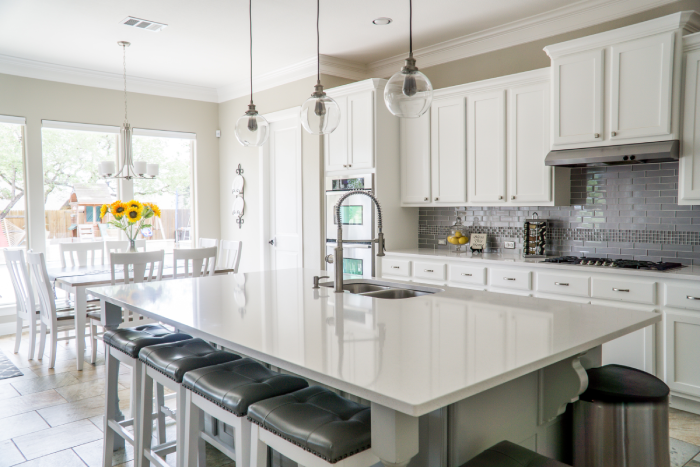Boston, also referred to as “The Hub” (never “Beantown”) is New England’s leading city in just about every respect: population, jobs, sports teams, historical significance, and universities.
As the home of the Red Sox, Celtics, Bruins, and the New England Patriots, for many, Boston is primarily a sports powerhouse. Others think of Boston first and foremost as a city of intellectuals due to Harvard and MIT being just across the river.
Although there is a city of Boston, many people use the city name to refer to the Metro Boston region, which extends from Saugus in the north to Weymouth in the south.
Boston is an ideal place to study, work, and raise a family with its eclectic array of arts and culture, restaurants, shopping destinations, outdoor activities, and historical sites. Here is what you need to know before you move.
Know Your Neighborhoods
Like many major American cities, Boston is experiencing an influx of young people who prefer living in swanky apartments in the city to spacious suburban homes. This has created an affordable housing crisis – many residents cannot manage the downtown area’s expensive housing costs and opt for a longer commute from a neighboring town instead.

The government is working to bridge the gap between these prices and the income of most of its expanding population, but this situation is unlikely to improve for the foreseeable future.
Despite these challenges, moving to Boston is still a viable and popular option for those who can afford the high cost of living. There are a number of attractive neighborhood and suburbs where you can choose to live, both within the city center and in the coastal communities surrounding it.
Pick an area based off your income bracket or finances. More affluent neighborhoods, like Beacon Hill or Back Bay, are prime real estate locations and the housing costs in these areas reflect that. These areas tend to be among the safest places to live and also where home security systems are most popular.

In contrast, properties in up-and-coming areas like Roslindale or East Boston will come at a more affordable price. Find a place that is central to the lifestyle and interests of you or your family. Commuting via car can be time-consuming, so factor in the distance and route from your place of work.
Regardless of where you choose to live, remember to take some basic steps to protect your home from burglary and fire. Overall crime rate in Boston is high relative to other cities in the US, so home security in Boston is a great way to both secure your home while you’re away and contribute to making your neighborhood safer. Plus, it lowers your insurance costs, too.
With so many buildings in Boston that are hundreds of years old and densely packed together, the risk of fire is very real. Make sure to update your smoke detectors if they’re over 10 years old. To learn more about the history and demographics of fires in Boston (as well as the rest of the state) and what you can do to reduce these risks, read up on our most recent blog post on the subject.
The Popular Suburbs near Boston
Belmont
For those wanting to get away from the hustle and bustle of Boston but not go too far, Belmont is the suburb for you. It is close enough to still commute into work and offers large parks and outdoor spaces to enjoy on the weekend. This suburb is pricey, however.
Beacon Hill
Arguably the most picturesque town because of the rows of historical houses and cobblestone streets. Walking at night along the gas-lit streets take you right back in time. It’s a popular place for both residents and tourists to explore.
Cambridge
Home to both MIT and Harvard, this suburb is home to more than just over-achieving college students. Families love the quiet, charming residential area and excellent public schools.
Winchester
A small suburban town in Boston that is popular with working professionals who commute into the greater metropolitan area. It has earned “Green Community” status because its residents make an effort to cut down on waste and keep the neighborhood environmentally-friendly.
Worcester
Pronounced “Wuhstah”, here you’ll feel the small-town charm while being a relatively short drive away from Boston, provided you plan around rush-hour traffic. Worcester is brimming with college students and residents alike. Purchasing a family home here is significantly cheaper than in other suburbs. It is also a popular place to start a pop-up shop or boutique.
The Cost of Living in Boston
Boston is one of the top five most expensive cities to live in in the country. If you plan on moving here, it is important to understand how it will affect your budget. Speak with a financial advisor or do research into the average living costs of the suburb prior to arriving.
It is possible to share an apartment, especially if you’re a young working professional without dependents or a college/graduate school student. It is also recommended to explore a variety of options to see what is available before purchasing a property online.
And if you’re the type that enjoys eating out or ordering take-out, this too will add up. With Boston’s endless selection of restaurants and cafes, it’s tempting to want to try them all out. As rent in the area is expensive, businesses need to mark up their products to cover such costs.
A local, inexpensive restaurant will set you back around $10-20 a main meal if you include tax and tip, while a three-course meal or fine dining experience starts at around $50 a person.

Massachusetts is a higher-tax state, so if you’re moving here from somewhere outside the region, be mindful of the possibility of paying more. Fortunately, flat taxes apply for income and sale taxes. Taxes on capital gains and owning an estate are where the catch lies, but these typically don’t apply to the average resident.
If you’re a sports fan, you’ll also need to pay the significantly higher ticket prices for the Boston Red Sox games due due to the immense popularity of the team and the size of their fan base. If you’re on a budget, there are many college and state sports teams to support that do not charge for admission.

Or if you’re not into sports, visit a museum or spend the day hiking along a trail or historical site. Public transportation is cheap too. A monthly pass gives you unlimited access to the Boston subway line (known as “the T”) and buses for just $90.00 a month as of July 1, 2019. When the trains aren’t derailed, on fire, or suffering from signal problems, public transportation is by far one of the most convenient ways to get around.

Boston’s Green Line subway, known for its characteristically loud screeching.
(Source: The Boston Globe)
The Top 10 Safest Neighborhoods in Boston
If you are considering relocating to some of the areas of Boston with the least crime according to data from the Boston Police Department, then this list of the 10 safest neighborhoods in the city is for you:
1. West Roxbury
With its clean, verdant parks, single-family homes, and quiet nights, West Roxbury not only looks but also feels like a suburb, despite its prime location near the heart of the city. In this neighborhood, there is a popular gourmet grocery store called Greek International Food Market and the highly-recommended Sofia Italian Steakhouse.
Maybe what makes West Roxbury popular with families with children, mature professionals and retirees, is its crime rate which is only 1.9%. Plus it’s about a 30-minute shuttle into the center of the city.
2. Charlestown
If you have seen The Departed, then you likely have a Hollywood-inspired image in your head about Charlestown being a major crime center. In reality, that’s far from the truth; Charlestown is one of the safest neighborhoods in Boston with a crime rating of just 2.14%.
Charlestown is not only for young professionals looking for more affordable housing but also for people who want to experience the historic waterfront neighborhood with Irish-American roots.
While Charlestown is a small neighborhood, there are a couple standout restaurants that are worth a visit like Monument and Brewer’s Fork.
3. Jamaica Plain
With a 16% drop in crime in 2016, Jamaica Plain is considered one of the safest places to live in Boston. It also best embodies the spirit of America in that it holds the most ethnic and income-diverse residents in all of Boston.
Despite the rise in the cost of real estate, the takeover of better eating establishments shows that there is a continuous and welcome change in the community. What’s most important is that the ties shared by families and loved ones remain on its grounds.
4. East Boston
Nicknamed Eastie by its beloved residents, East Boston has a little over 40,000 diverse residents and has seen a lot of transformation especially in the areas around the Maverick T stop. One of the most significant issues the neighborhood has faced in the past is its history of crime.
However, law enforcement efforts and gentrification have contributed to reducing the crime rate 1.29%, a 16% decrease from 2016. What’s more, East Boston brands itself as a neighborhood that’s welcoming to members of every race, culture, family size, and sexual orientation. Few people outside of East Boston realize that there are quite a few great restaurants to be found here, from Santarpio’s Pizza to Taqueria Jalisco.
5. Hyde Park
Hyde Park is a neighborhood in Boston that is known for being low-crime, and for good reason. But what makes people love this town is the fact that it is well-maintained with dashes of green on every corner, offering a respite from the concrete (and brick!) jungle of downtown. Despite the 6% increase in crime in 2016, Hyde Park is still one of the safest places in Boston.
6. Dorchester
Dorchester is another part of Boston that has become an amalgam of cultures from Irish-Americans and African Americans to Latinx and a distinctive LGBTQ+ community.
The town is known for its close proximity to Boston harbor and a number of popular green areas and parks courtesy of father of American landscape architecture Frederick Law Olmsted. If you plan to visit or relocate, there are sites like The James Blake House (the oldest house in Boston), Franklin Park Zoo, Dorchester Park, and Franklin Park to get in some bonding time with your family and loved ones.
You can find great Vietnamese food here like Ba Le and Ánh Hồng Restaurant, as well as succulent burgers at Bred Gourmet.
7. Allston/Brighton
Allston/Brighton is an up-and-coming area that’s increasingly being taken over by college students and recent graduates fleeing the sky-high rent closer to the city. It’s known for having a great selection of restaurants that are of comparable or superior quality to their competitors downtown for a much lower price such as Carlo’s Cucina and Coreanos Allston.
No matter where you turn, you’ll have no trouble spotting college kids from Harvard, MIT, BU, and Northeastern walking the streets or sipping artisanal beverages in the numerous coffee shops and bars. With regards to safety, in 2017 there were 904 total crimes that took place in a population of 45,801 people, which is a 2% increase from 2016.
8. Mission Hill
Mission Hill is a diverse neighborhood that has seen a recent upsurge in new condos and brick row houses, which is surrounded by Fenway/Kenmore, Roxbury, Jamaica Plain, and Brookline. Mission Hill is cheap and offers something for everybody’s taste.
In addition, this is one of many areas that the Boston Police Department is delegating a lot of their resources to keeping safe. As of 2016, only 1,950 total crimes were reported over a population of 64,759.
9. South Boston
South Boston or “Southie” was once predominately a working-class Irish Catholic community, but these days, it has become a hot spot for young professionals looking for a swanky new pad only minutes away from their office or a short jaunt on the MBTA.
South Boston comprises Dorchester Heights – where George Washington forced British troops to vacate during the American Revolutionary War. With the area becoming increasingly gentrified, crime rates have also declined to the point where it is now one of Boston’s safer places to live.
South Boston and Seaport have some great seafood joints like Row 34, James Hook and Co, Ocean Prime, and Yankee Lobster.
10. Back Bay
Back Bay is more or less in the heart of Boston and only a short ride on the Green Line trolleys away from just about everything (assuming the Green Line isn’t experiencing “major delays”).
It is also home to some of the most beautiful real estate in town with many brownstones dating back to centuries ago. If you’ve got something you want to buy, chances are you can find a store on Newbury Street.
For a more relaxing day, check out the Boston Public Library and flip through its massive collection of books or take a stroll through the Public Garden. As for safety, only 2,675 total crimes were reported in 2017 over a population of 76,461 people, a 16% decrease from 2016.
The Back Bay has some of the best restaurants in the city, along with some of the more high-end spots. Sorellina, Deuxave, Grill 23 & Bar, Ostra, and Bistro du Midi are just a few of the most popular upscale options available to you.
Learn How To Get Around Boston
Depending on who you speak with, you’ll receive a mixed list of preferred means of transportation. Boston’s road infrastructure may suffer from a lack of lane markings and confusing one-way streets, but the good news is that the city is small enough to where you can drive from one end to the city of the other reasonably quickly in off-peak hours.
The traffic in and out of the city, especially during rush hours, can be frustrating. So much so that griping about transit problems is a favorite go-to conversation topic.

The Mass Pike, a highway which runs through the heart of Boston.
(Source: The Boston Globe)
Don’t let that deter you from living or commuting here. In Boston and its surrounding suburbs, there are reasonably efficient — if somewhat antiquated — public transportation systems in place. And if you’re fortunate enough to live close to a commuter rail station, T stop, or bicycle lane, you may not even need to own a car.
Boston has also been nicknamed “America’s Walking City” for good reason. There are now plenty of sidewalks and pathways that allow one to easily navigate around the busy city districts.
If you do need a car, however, driving isn’t all that bad once you learn how to dodge the potholes. Not to mention that Boston drivers all seem to forget that turn signals exist. If you can, it’s best to use public transportation for commuting and save the car for running errands or traveling outside of the city.

To avoid traffic, keep in mind what weekends there are major sports games scheduled. Expect slowdowns before and after such events as the streets suddenly fill with cars. Remember to apply for a parking permit if it is not provided by your employer, as parking space in the city is limited.
Finding Work in Boston
This will vary depending on your qualifications and career choice. Boston is a major city in the United States and supports a large and growing workforce. You’ll find everything here from small startups to massive Fortune 500 companies.
There are always positions available for employees, it is just a matter of crafting a good CV and going out there and applying. The city itself is always looking for those eager to join their team. Use job posting websites to help you find work in your desired field and secure interviews prior to arriving.
Things to Do in Boston
You will never be bored living here. Few other cities can offer as many attractions and historical points of interest as Boston. It is rich in both culture and history, and can be explored affordably and on foot. Besides common tourist hotspots like the Boston Harbor Islands, Fenway Park, and Harvard University’s campus, there are many hidden gems to be explored.

Walk the Freedom Trail and hear stories about the founding of the nation as you stroll through a series of important locations and landmarks in the American Revolution. Along the way, you’ll see renowned landmarks like the Old North Church, Paul Revere’s home, and the USS Constitution.
Visit one of the city’s many cultural institutions. Our favorites are:
- Boston Museum of Fine Art
- Museum of Science
- Boston Children’s Museum
- New England Aquarium
- Isabella Stewart Gardner Museum
- The Institute of Contemporary Art
- Harvard Museum of Natural History
- Mary Baker Eddy Library
- Peabody Museum of Archaeology and Ethnology
Making It Happen
It is natural to feel a sense of anxiety and excitement when moving homes. It is also easy to overlook the small details and get caught up in this process. Take it slow and plan carefully. Do as much research as possible into the suburbs and properties available.
Take the time to explore the surroundings when you first arrive. And most of all, enjoy and keep an open mind. Boston is a big city, but the move will be rewarding.






